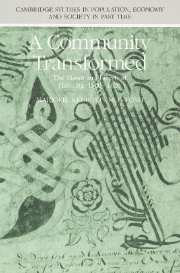Book contents
- Frontmatter
- Contents
- List of figures
- List of tables
- Acknowledgements
- Abbreviations
- Introduction
- 1 Life and death
- 2 Changing economic patterns
- 3 Religion
- 4 Facets of a society in transition
- 5 Havering's declining independence
- 6 Overt conflict, 1607–19
- Conclusion
- Appendices
- Bibliography
- Index
- Cambridge Studies in Population, Economy and Society in Past Time
6 - Overt conflict, 1607–19
Published online by Cambridge University Press: 11 October 2009
- Frontmatter
- Contents
- List of figures
- List of tables
- Acknowledgements
- Abbreviations
- Introduction
- 1 Life and death
- 2 Changing economic patterns
- 3 Religion
- 4 Facets of a society in transition
- 5 Havering's declining independence
- 6 Overt conflict, 1607–19
- Conclusion
- Appendices
- Bibliography
- Index
- Cambridge Studies in Population, Economy and Society in Past Time
Summary
The changes which transformed Havering over the course of the sixteenth century were in most cases gradual. The new patterns seen in demographic and economic structures, religion, society, and local government/law appeared slowly, though their cumulative impact was substantial. In the early seventeenth century, however, Havering experienced a period of crisis. Two forms of overt conflict disrupted the community, one between the uppermost families, the other initiated by royal officials. These brought into the open the underlying divisions within the community and revealed its vulnerability to outside interference, particularly its weakness against its most formidable potential adversary, the Crown. In these years we see the culmination of the broad developments we have been tracing since 1500: the loss of Havering's sense of shared experience and purpose, the gathering of economic and political power into a few hands, a shift in the locus of social control, and the integration of the community into a wider context.
Conflicts among the leading families
By the early seventeenth century, political power within Havering had become concentrated. Office-holding in local government and the parishes was no longer shared among a broad range of families, including men from the commercial as well as the agricultural worlds. Now local affairs were dominated by the larger landholders – the gentlemen, upper yeomen, and farmers of the major demesnes. Craftsmen and traders had been almost entirely displaced from power. As Table 6.1 summarises, the commercial groups had filled 64–78% of the places on local bodies between 1489 and 1535.
- Type
- Chapter
- Information
- A Community TransformedThe Manor and Liberty of Havering-atte-Bower 1500–1620, pp. 364 - 401Publisher: Cambridge University PressPrint publication year: 1991

